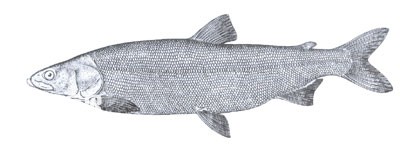Northern salmon (Stenodus leucichthys) belongs to the order Salmoniformes, family Salmonidae, and genus Stenodus leucichthys. Commonly known as: big white fish. English name: Inconnu.
Endangerment level: extinct (domestic).
The body is long, the sides are flat, the tail stalk is short, the snout is not prominent, and there are fat eyelids on the edge of the eyes. The eyes are widely spaced. At the end of the mouth, the lower jaw is slightly longer than the upper jaw, and the rear end of the maxilla reaches below the posterior edge of the eye; the teeth on the upper and lower jaws, vomer, palatine and tongue are all very small. The lateral line is straight, with 103-111 lateral line scales. The first branch of the dorsal fin has the longest ray, and the fat scale is smaller; the end of the anal fin base is opposite to the end of the fat scale, and the lower edge is slightly concave, and the 1-2 branch fins are the longest; the caudal fin is forked. The back of the body is gray, the sides are lighter, and the belly is silvery white.

Northern salmon are widely distributed in rivers in the Arctic Ocean water system. Due to the restriction of geographical conditions, northern salmon has formed two ecotypes with large differences in ecological characteristics, namely the river type and the semi-migratory type. The population distributed in the lower reaches of the Irtysh River in Xinjiang, my country, belongs to the river type. They live in rivers throughout their lives. Older fish mostly live in the upper reaches, while younger fish tend to gather in the lower reaches. Northern salmon grows quickly and reaches sexual maturity at age 3+. In autumn, they migrate upstream for reproduction and lay eggs in river sections with no weeds, slow water flow, water depth of 3-4 meters, and gravelly bottom. The hatched larvae flow down the river and enter the middle and lower reaches of the Irtysh River and the Ob River in Russia for growth and fattening. The ones captured in my country are all spawning groups, with larger individuals and generally weighing more than 2.5 kilograms.
In the early 1960s, the annual catch in northern Xinjiang reached 10 tons, and it was the main fishing target of the Irtysh River. Later, due to the opening of canals to divert water from the middle and lower reaches of the Irtysh River in Russia, the amount of water flowing from the Irtysh River into the Ob River was reduced, which affected the upstream spawning of northern salmon. Since the 1960s, the output has increased year by year. decline. By the 1980s it was extremely rare and almost extinct.
animal tags: Inconnu
We created this article in conjunction with AI technology, then made sure it was fact-checked and edited by a Animals Top editor.